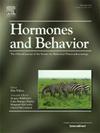Effect of exogenous manipulation of glucocorticoid concentrations on meerkat heart rate, behaviour and vocal production
IF 2.4
3区 医学
Q2 BEHAVIORAL SCIENCES
引用次数: 0
Abstract
Encoding of emotional arousal in vocalisations is commonly observed in the animal kingdom, and provides a rapid means of information transfer about an individual's affective responses to internal and external stimuli. As a result, assessing affective arousal-related variation in the acoustic structure of vocalisations can provide insight into how animals perceive both internal and external stimuli, and how this is, in turn, communicated to con- or heterospecifics. However, the underlying physiological mechanisms driving arousal-related acoustic variation remains unclear. One potential driver of such variation in behaviour and vocal production are glucocorticoids. Through exogenous glucocorticoid manipulation, we aimed to gain insight on the relationship between arousal and physiological parameters, behaviour and vocal production in wild meerkats (Suricata suricatta). To this aim, we administered glucocorticoids to wild meerkats, and recorded their heart rate, vigilance behaviour, call rate and acoustic structure during natural behavioural contexts. The results suggest that, although the glucocorticoid treatment did increase plasma glucocorticoid levels, this did not result in observable changes in heart rate, vigilance, or vocal production. This lack of treatment effect suggests that, while glucocorticoids may be a significant component and correlate of the arousal response, they are not the direct drivers of affective arousal related changes in heart rate, behaviour, or vocal production.
外源性操纵糖皮质激素浓度对猫鼬心率、行为和发声的影响。
在动物王国中,通常可以观察到声音中情绪唤醒的编码,它提供了一种关于个体对内部和外部刺激的情感反应的快速信息传递手段。因此,评估发声的声学结构中与情感唤醒相关的变化可以深入了解动物如何感知内部和外部刺激,以及如何将其传达给非特异性或非特异性。然而,潜在的生理机制驱动觉醒相关的声学变化仍不清楚。这种行为和声音产生变化的一个潜在驱动因素是糖皮质激素。通过外源性糖皮质激素操纵,我们旨在深入了解唤醒与野生猫鼬(Suricata suricatta)生理参数、行为和发声之间的关系。为此,我们给野生猫鼬注射糖皮质激素,并记录了它们在自然行为环境下的心率、警觉行为、呼叫率和声音结构。结果表明,虽然糖皮质激素治疗确实增加了血浆糖皮质激素水平,但这并没有导致心率、警惕性或声音产生的可观察到的变化。这种治疗效果的缺乏表明,虽然糖皮质激素可能是唤醒反应的重要组成部分和相关因素,但它们并不是心率、行为或声音产生的情感唤醒相关变化的直接驱动因素。
本文章由计算机程序翻译,如有差异,请以英文原文为准。
求助全文
约1分钟内获得全文
求助全文
来源期刊

Hormones and Behavior
医学-行为科学
CiteScore
6.70
自引率
8.60%
发文量
139
审稿时长
91 days
期刊介绍:
Hormones and Behavior publishes original research articles, reviews and special issues concerning hormone-brain-behavior relationships, broadly defined. The journal''s scope ranges from laboratory and field studies concerning neuroendocrine as well as endocrine mechanisms controlling the development or adult expression of behavior to studies concerning the environmental control and evolutionary significance of hormone-behavior relationships. The journal welcomes studies conducted on species ranging from invertebrates to mammals, including humans.
 求助内容:
求助内容: 应助结果提醒方式:
应助结果提醒方式:


